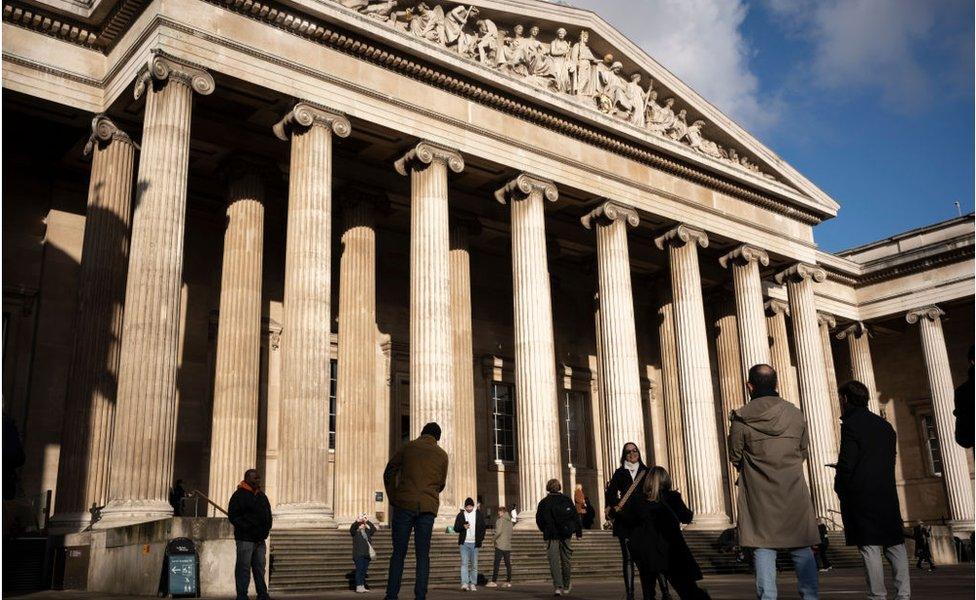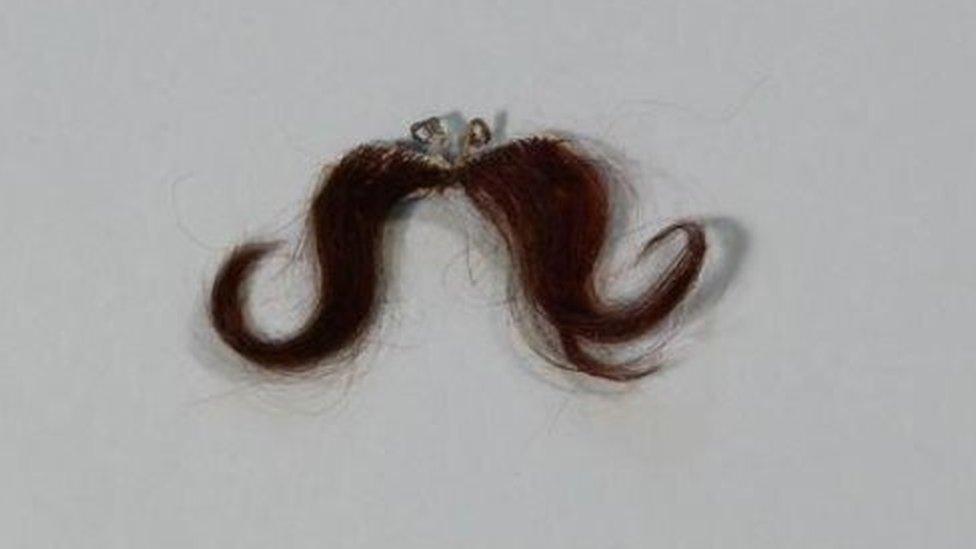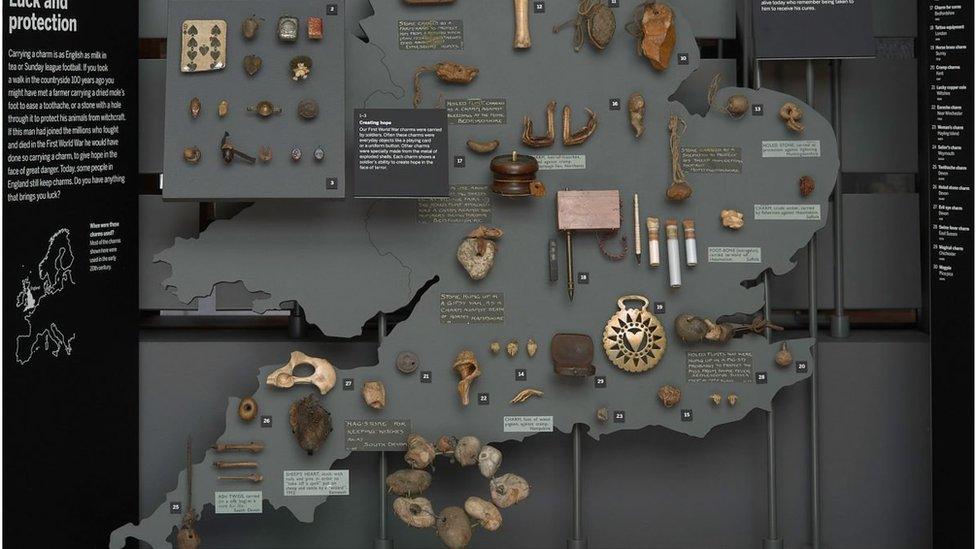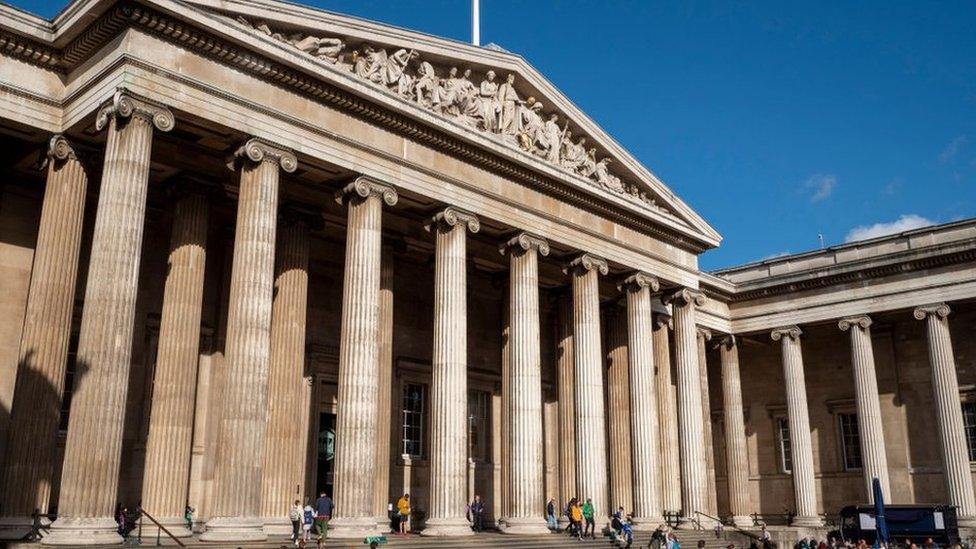Pants, moustaches and bird livers among missing museum artefacts
- Published

More than 2,000 artefacts went missing, believed stolen, from the British Museum
A false moustache and a Queen Victoria drawing are among more than 1,700 items missing from museums in England.
Freedom of information requests to museums and galleries which receive public funding asked for details on absent items from the last 20 years.
It comes after British Museum member of staff was sacked after more than 2,000 artefacts disappeared.
Other unusual missing items include a Saddam Hussein calendar and an aircraft navigational system.

National Portrait Gallery

Some of the missing items appear in catalogues without an image
The National Portrait Gallery, which reopened in 2023 following a three-year refurbishment, has 45 "not located" items - but insists they are not missing or stolen.
Between 2007 and 2022, a drawing of Queen Victoria from 1869, a mid-19th Century engraving of King John granting the Magna Carta, a bronze sculpture of painter Thomas Stothard and a 1947 negative image of the wedding of the late Queen to the Duke of Edinburgh, were recorded as "not found".
The gallery said it still needs to complete searches for items following a three-year refurbishment and items recorded as unlocated represent 0.02% of its collection, which houses 12,700 portraits and 164,000 images.
"The bulk of the items currently not located are photographic negatives and for the majority of those, the image has been digitally scanned and is available to the public as part of our online collections database," the museum said.

The Victoria and Albert Museum

A false moustache in the V&A collection - this one is not on display but it is not known if it is one of the missing items
Oil and watercolour paintings, a shadow puppet, false moustaches, various drawings, underpants, stockings and a mousetrap were among its more than 180 missing artefacts.
No descriptions of the items or when they went missing were released and the Kensington design institution said it was "standard practice to have a list of missing items as part of our regular auditing".
A V&A spokeswoman said the museum takes "the protection of national collections very seriously and regularly reviews our security and collection management procedures".
"This does not mean these objects have been stolen or lost, it might mean for example that a catalogue entry has not been updated after a collection move. Items are regularly recovered as a result of this process," they said.

Royal Museums Greenwich Group

This cannonball is not one of those missing - it is on display in the Traders Gallery
This group includes the National Maritime Museum, Queen's House, the Royal Observatory, Greenwich and Cutty Sark.
About 245 items cannot be found, including a cannonball, a navigational aircraft computer, a gun-sighting telescope, charts, liquid compasses, an Act of Parliament, an Altazimuth circle (a mount for holding and rotating an instrument, such as telescopes) and ribbons and bands for caps.
The museum said these could be "ghost entries" - the result of data transfer from more primitive databases; incorrect documentation or human error in the past. They have, however, re-discovered 560 items since 2008 through audits.

The Natural History Museum

Feathers, muscle, and liver samples from Tasmanian fairy prions (Pachyptila turtur) were destroyed
A jaw fragment of a Late Triassic reptile, the Diphydontosaurus, was found to have been lost during a loan in 2019 - and the next year more than 180 fish were recorded as lost, and a crocodile tooth was discovered stolen in 2020.
In the past three years, Cichlid fish were lost by researchers while on loan, 20 animal cells were destroyed from documentation not being presented while shipping a collection, and around 24 genomic tissues from octopi and birds were also lost when they were not properly refrigerated.
Feathers, muscle, and liver from short-tailed shearwaters and fairy prions from Tasmania, Australia were also destroyed due to not being properly cooled and failing to be present for inspection.
However, as these items were not catalogued, it is not clear how many samples were lost.
A Natural History Museum spokesman said: "We take the security of our collection very seriously, so over the last 20 years we've had just 23 instances of lost or missing items from a collection of 80 million, limited to small things like teeth, fish and frozen animal tissue.
"We have robust security measures in place which we regularly review.
"As a world-leading science centre, it's important that researchers from around the world have access to our collection to help find solutions to the planetary emergency."

The Science Museum Group

Two model steam trains were stolen from the Science Museum Group in 2014
The body includes the Science Museum in South Kensington, the Science and Industry Museum in Manchester, the National Railway Museum in York, the Locomotion Museum in Shildon, Co Durham and the National Science and Media Museum in Bradford.
In 2014, the group reported to police the theft of two model steam trains, a King George V and a British Railways Standard 4MT class.
The museum also has recorded as missing a 1960s model of a deep-sea observation chamber, a diver's watertight torch, resuscitating apparatus and a 19th-century portrait of Joseph Marie Jacquard (who developed a programmable loom).
The group, which houses 425,000 objects across its venues and centres, has begun putting barcodes on artefacts to track their locations and keep them safe.

Horniman Museum and Gardens

Display of non-missing charms from across England
Seven artefacts, including a 1933 protective charm are missing from the Horniman, which has displays of anthropology, natural history and musical instruments, and is known for its large collection of taxidermy animals.
It said it has "reviewed" security in light of thefts at the British Museum "as a precautionary measure".

Imperial War Museums

A Saddam Hussein calendar has gone missing, but a rubber dog toy remains in the catalogue
More than 550 objects, made up of ship camouflage drawings, British Army officer's private papers, a calendar with a photograph of former Iraq leader Saddam Hussein and currency notes, were disclosed by the Imperial War Museum when asked about missing items.
A museum spokesman said the artefacts "date from many years or even decades ago, long before our current collections management systems were put in place" and "are also typically low-value, mass-produced items".
It emerged in November that a 19th-Century cannon from the Royal Armouries collection was stolen from a remote and off-site location.
It was claimed to be a metal theft, meaning the cannon was thought to have been taken for its scrap value, rather than stolen as a "collection object".
A pair of mounted sword bayonets also disappeared while on loan from the museum.

Listen to the best of BBC Radio London on Sounds and follow BBC London on Facebook, external, X, external and Instagram, external. Send your story ideas to hello.bbclondon@bbc.co.uk
- Published16 August 2023
